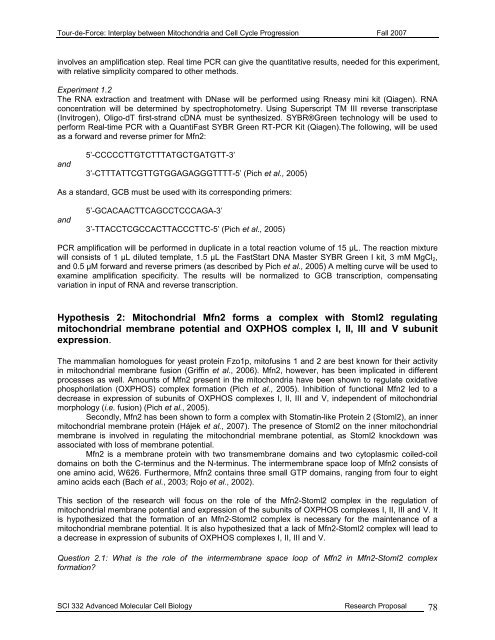Tour-de-Force
Tour-de-Force
Tour-de-Force
You also want an ePaper? Increase the reach of your titles
YUMPU automatically turns print PDFs into web optimized ePapers that Google loves.
<strong>Tour</strong>-<strong>de</strong>-<strong>Force</strong>: Interplay between Mitochondria and Cell Cycle Progression Fall 2007involves an amplification step. Real time PCR can give the quantitative results, nee<strong>de</strong>d for this experiment,with relative simplicity compared to other methods.Experiment 1.2The RNA extraction and treatment with DNase will be performed using Rneasy mini kit (Qiagen). RNAconcentration will be <strong>de</strong>termined by spectrophotometry. Using Superscript TM III reverse transcriptase(Invitrogen), Oligo-dT first-strand cDNA must be synthesized. SYBR®Green technology will be used toperform Real-time PCR with a QuantiFast SYBR Green RT-PCR Kit (Qiagen).The following, will be usedas a forward and reverse primer for Mfn2:and5’-CCCCCTTGTCTTTATGCTGATGTT-3’3’-CTTTATTCGTTGTGGAGAGGGTTTT-5’ (Pich et al., 2005)As a standard, GCB must be used with its corresponding primers:and5’-GCACAACTTCAGCCTCCCAGA-3’3’-TTACCTCGCCACTTACCCTTC-5’ (Pich et al., 2005)PCR amplification will be performed in duplicate in a total reaction volume of 15 µL. The reaction mixturewill consists of 1 µL diluted template, 1.5 µL the FastStart DNA Master SYBR Green I kit, 3 mM MgCl 2 ,and 0.5 µM forward and reverse primers (as <strong>de</strong>scribed by Pich et al., 2005) A melting curve will be used toexamine amplification specificity. The results will be normalized to GCB transcription, compensatingvariation in input of RNA and reverse transcription.Hypothesis 2: Mitochondrial Mfn2 forms a complex with Stoml2 regulatingmitochondrial membrane potential and OXPHOS complex I, II, III and V subunitexpression.The mammalian homologues for yeast protein Fzo1p, mitofusins 1 and 2 are best known for their activityin mitochondrial membrane fusion (Griffin et al., 2006). Mfn2, however, has been implicated in differentprocesses as well. Amounts of Mfn2 present in the mitochondria have been shown to regulate oxidativephosphorilation (OXPHOS) complex formation (Pich et al., 2005). Inhibition of functional Mfn2 led to a<strong>de</strong>crease in expression of subunits of OXPHOS complexes I, II, III and V, in<strong>de</strong>pen<strong>de</strong>nt of mitochondrialmorphology (i.e. fusion) (Pich et al., 2005).Secondly, Mfn2 has been shown to form a complex with Stomatin-like Protein 2 (Stoml2), an innermitochondrial membrane protein (Hájek et al., 2007). The presence of Stoml2 on the inner mitochondrialmembrane is involved in regulating the mitochondrial membrane potential, as Stoml2 knockdown wasassociated with loss of membrane potential.Mfn2 is a membrane protein with two transmembrane domains and two cytoplasmic coiled-coildomains on both the C-terminus and the N-terminus. The intermembrane space loop of Mfn2 consists ofone amino acid, W626. Furthermore, Mfn2 contains three small GTP domains, ranging from four to eightamino acids each (Bach et al., 2003; Rojo et al., 2002).This section of the research will focus on the role of the Mfn2-Stoml2 complex in the regulation ofmitochondrial membrane potential and expression of the subunits of OXPHOS complexes I, II, III and V. Itis hypothesized that the formation of an Mfn2-Stoml2 complex is necessary for the maintenance of amitochondrial membrane potential. It is also hypothesized that a lack of Mfn2-Stoml2 complex will lead toa <strong>de</strong>crease in expression of subunits of OXPHOS complexes I, II, III and V.Question 2.1: What is the role of the intermembrane space loop of Mfn2 in Mfn2-Stoml2 complexformation?SCI 332 Advanced Molecular Cell Biology Research Proposal 78
















